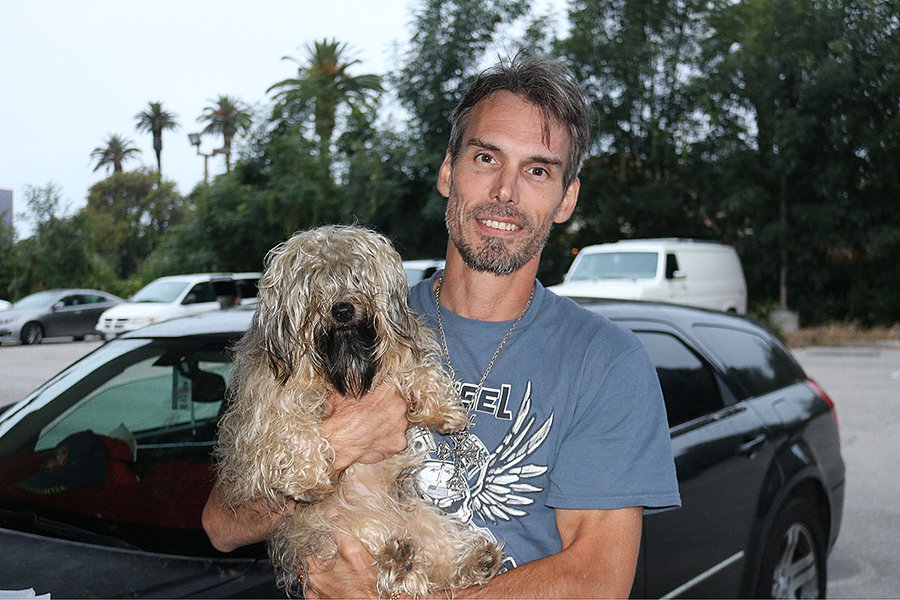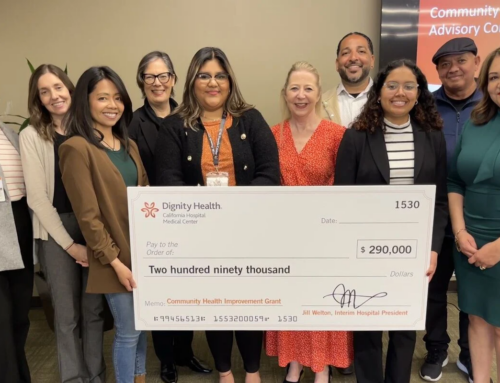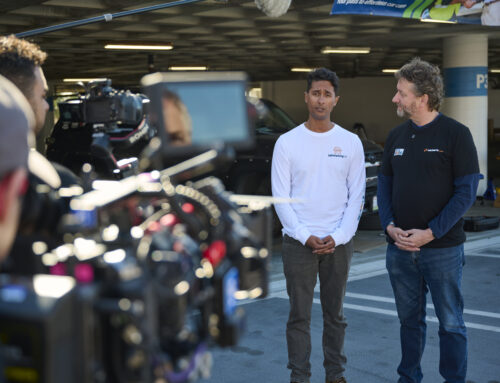Dusk is approaching as a Ford van pulls up to the gate of a parking lot here on the sprawling health care campus of Veterans Affairs Greater Los Angeles.
The driver rolls down his window. “I just want to say thank you,” he says to the woman standing at the gate, his voice full of heartfelt gratitude. She asks about his day, as his black-and-white cat hops from the passenger seat to the open window, searching for a pat.
It’s been a tough one for this actor and veteran, who is living in his van and looking for housing. He has the help of the Department of Veterans Affairs, but has not yet been able to find an apartment. Still, at least he has a safe place to park at night, thanks to the woman at the gate, Pat Cohen, and her husband, Ira, who helped found the nonprofit Safe Parking LA.
In Los Angeles County, a staggering 16,500 people live in their vehicles. But at this lot and six others run by the nonprofit, police won’t tell them to move along when they bed down. They won’t have to fear someone breaking into their car. They have access to portable toilets, wash stations, food, and caseworkers.
Operated by the nonprofit Safe Parking LA, this lot at the west L.A. campus of Veterans Affairs Greater Los Angeles enables homeless vets to sleep safely in their cars.
“It’s a godsend for people that have vehicles,” says Joe Hidalgo, standing in front of his Chevy Silverado pickup truck. The former Marine from Bakersfield, California, removes the center console between the front seats to sleep – not exactly comfortable on his back. But he hopes to qualify for a VA housing voucher. Half of the people who use the lot, which is just for veterans, find permanent housing.
Safe Parking LA is an example of a relatively new effort on the West Coast to assist a specific group of individuals before they fall further to life on the street. Many of them may be working or have some source of income and are homeless for the first time. Designated parking lots, supported entirely by charity or with public funds, now dot cities from San Diego to Seattle, with some officials trying to figure out how to scale up their programs.
As California struggles with the highest homelessness in the nation, state lawmakers are considering legislation that would mandate safe parking programs for cities and counties with populations over 330,000. Another measure would require the state’s community colleges to keep their lots open for students at night. Nearly 20% of students at California’s community colleges experienced homelessness in the past year.
“We’re in a crisis situation, and we have to think of the whole ecosystem of services, and protect people vulnerably housed in whatever situation they might be,” says Gary Painter, director of the Homelessness Policy Research Institute at the University of Southern California in Los Angeles.
“It’s almost like our eyes have been closed to the fact that so many people are living right in their car, the last step before the streets. We’ve done nothing about this population, other than to tell them, ‘You can’t park on this or that street,’” he says.
Nikki Baker, an official of VA Greater Los Angeles, speaks with homeless veteran Joe Hidalgo, June 18.
Safe parking programs are generally located on the West Coast where weather allows for year-round living in vehicles. Parking areas vary in size, from lots that can take 15 vehicles to ones like that at the VA campus, which can accommodate 50. The programs usually require a valid driver’s license, registration, and insurance, and they screen for sex offenders and violent felons. Most operate only at night, with access to caseworkers. The success rate in finding permanent housing varies widely, from 5% in Santa Barbara to 65% in San Diego, according to a December report on safe parking by the Homelessness Policy Research Institute.
But this idea has its detractors. Some question it on ethical grounds, saying it normalizes vehicular living, explains Professor Painter. Others fear drugs, crime, and waste, and don’t want the lots in their areas. That’s one reason why some lots employ security guards.
Teresa Smith, who directs the nonprofit Dreams for Change in San Diego, says these fears are groundless. She describes her parking lot clients as a “very different population” from people living on the street. “You don’t see the same issues of drugs and mental health. We’re trying to dispel some of those myths.”
The group runs two parking lots that service 70 families and individuals. They aim to keep people in or near the communities where they had housing, and to preserve their one asset – their vehicles – so they can continue to look for housing, jobs, and get their children to school, or continue working. More than two-thirds of the people who use the lots have some kind of income, she says.
The key to the success of these programs is the individual case management and social work, clarity of the rules on the lots, and confidence in safety, says Professor Painter. But the number of lots does not come close to meeting the demand for people already living in their vehicles. To scale up would require a tremendous investment in resources, he and others say.
Heidi Marston, chief program officer for the Los Angeles Homeless Services Authority, says that when safe parking was first conceptualized, it was thought of as almost “cost neutral,” leveraging resources from other sources, like churches. The concept assumed that parking lots would be “sort of self-monitoring.”
But the authority, which began a safe parking pilot program in 2017 and now funds 12 lots in the county with 130 spaces, has discovered these lots come with a price tag – an average $35 per space per night. As it seeks to at least double its program with the help of nonprofits, security is a big expense. Then there’s the complexity of supplying social workers outside normal business hours.
In San Diego, Dr. Smith says Dreams for Change runs at a third of the cost of the program run by the city, which just opened a third lot.
“We believe in lean, mean, and efficient,” she says, explaining that they have found no need for security because their clients are “respectful” of each other. Instead, she spends that money on a staff of full-time social workers augmented by interns studying social work. Using a church parking lot with bathrooms also saves on portable toilets.
Whether it’s safe parking in San Diego or in LA County, however, the ultimate challenge is a shortage of affordable housing. In greater LA, more than 21,000 people found permanent housing last year. But the number of homeless people increased by 12%. Dr. Smith says that while it used to take three months to find housing for her clients, now it takes six months. While Dreams for Change may have had a success rate of 65%, now it’s 30% to 35%.
Anthony Flowers and his family of four found their answer far from LA – in Chicago. From September to November of last year, they overnighted at the VA lot in their two cars. His wife, April, made a bed for the family in their Chevy Equinox SUV. She and her two young daughters washed up with bottles of water and a cup in the wheelchair accessible portable toilet. Her husband, a Navy vet on disability, had income – but not enough for LA-style rent.
“Living in your car is hard. It really plays with your mind. We have money, but we can’t afford rent,” recalls April in a phone interview. Through the VA, the family eventually got vouchers for an apartment, and were able to save up to buy an abandoned house in Chicago. The grand total for that purchase: $2,000. The family is now working on fixing it up.
https://www.safeparkingla.org/news/https/wwwcsmonitorcom/usa/society/2019/0701/car-but-no-home-safe-parking-lots-spread-across-west-coast




